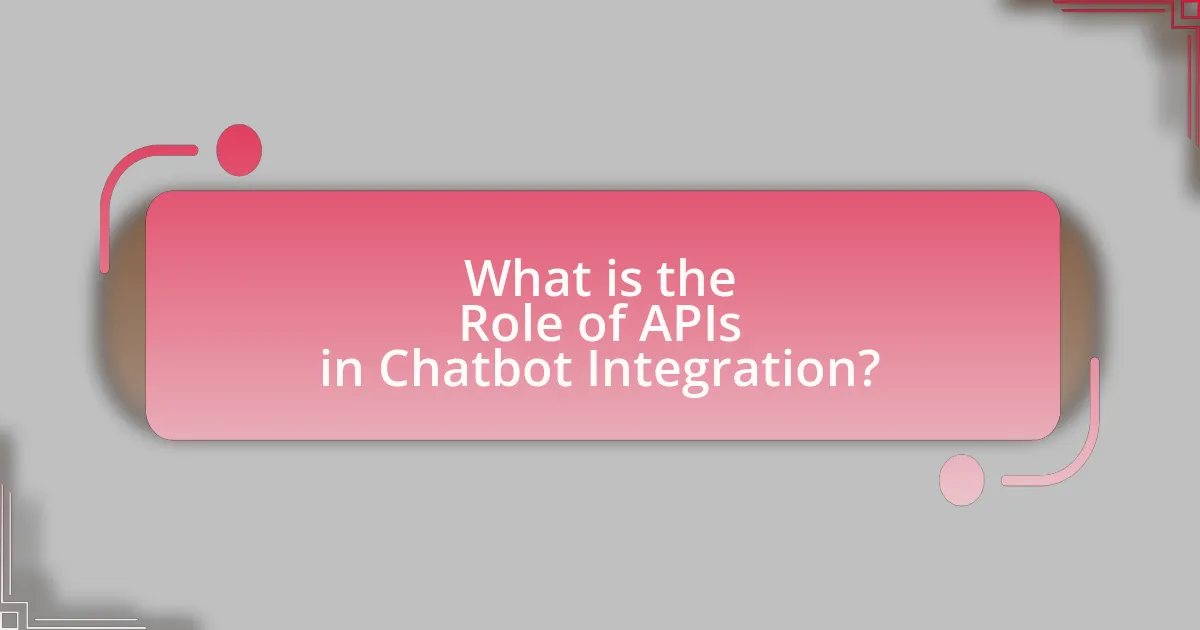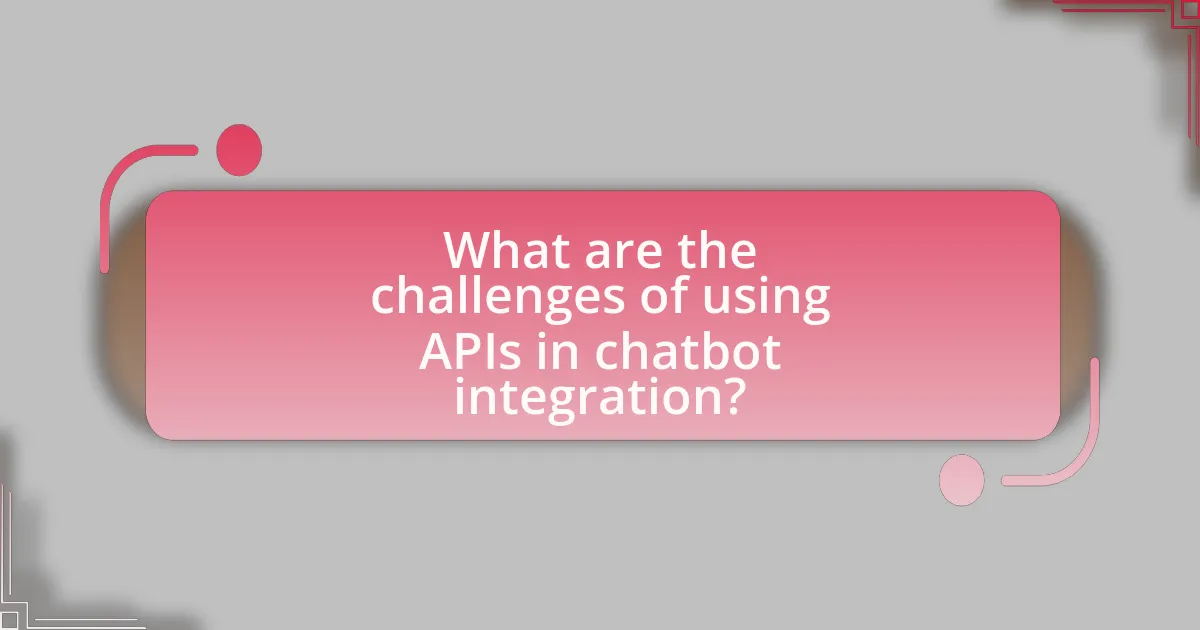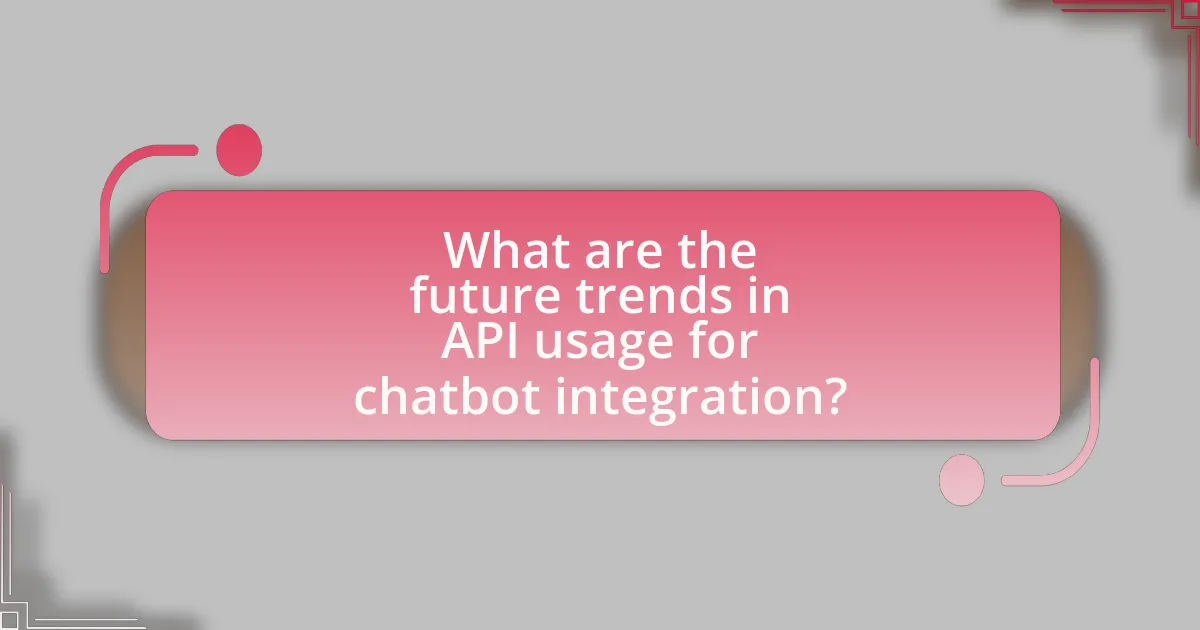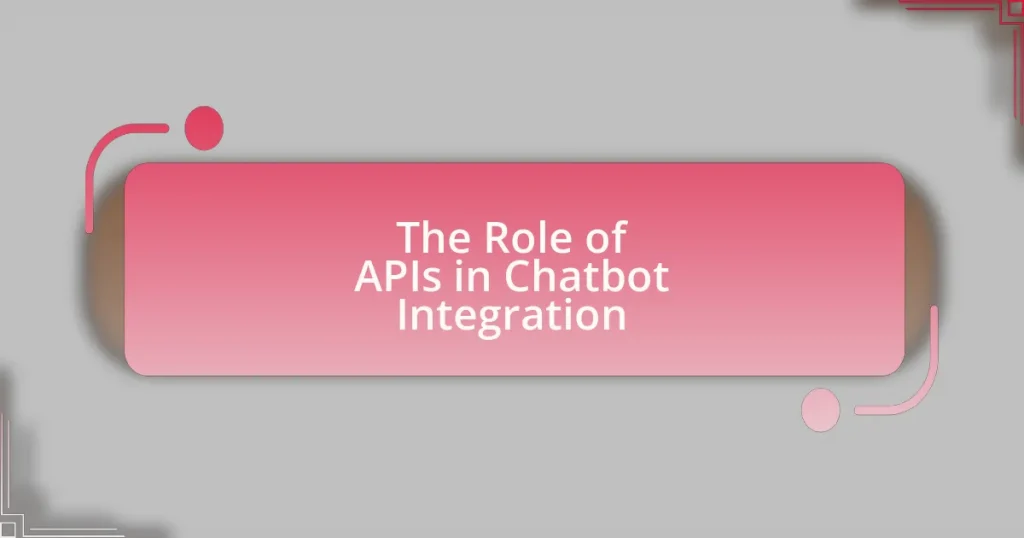The article focuses on the role of APIs in chatbot integration, highlighting how APIs facilitate communication between chatbots and external systems, enhancing their functionality and user experience. It discusses various types of APIs commonly used in chatbot applications, such as messaging platform APIs, natural language processing APIs, and third-party service APIs. The article also examines the differences between RESTful and SOAP APIs, the challenges of API integration, and best practices for effective implementation. Additionally, it explores future trends in API usage, including the impact of emerging technologies like AI and machine learning on chatbot capabilities.

What is the Role of APIs in Chatbot Integration?
APIs facilitate communication between chatbots and external systems, enabling seamless integration of functionalities and data exchange. By using APIs, chatbots can access various services such as databases, third-party applications, and machine learning models, which enhances their capabilities. For instance, a chatbot can utilize a payment processing API to handle transactions or a weather API to provide real-time updates. This integration allows chatbots to deliver more personalized and contextually relevant interactions, ultimately improving user experience and operational efficiency.
How do APIs facilitate communication between chatbots and external services?
APIs facilitate communication between chatbots and external services by providing a standardized interface for data exchange. This interface allows chatbots to send requests to external services, retrieve information, and perform actions based on user input. For example, when a user asks a chatbot for weather information, the chatbot uses an API to request data from a weather service, which then returns the relevant information in a structured format. This process enables real-time interactions and enhances the chatbot’s functionality by integrating external data sources, such as databases or third-party applications, thereby improving user experience and service efficiency.
What types of APIs are commonly used in chatbot integration?
Commonly used APIs in chatbot integration include messaging platform APIs, natural language processing (NLP) APIs, and third-party service APIs. Messaging platform APIs, such as those from Facebook Messenger and Slack, enable chatbots to send and receive messages within those platforms. NLP APIs, like Google Cloud Natural Language and IBM Watson, allow chatbots to understand and process human language, enhancing their conversational capabilities. Third-party service APIs, such as payment processing or customer relationship management (CRM) APIs, enable chatbots to perform specific tasks, like processing transactions or accessing customer data, thereby improving user experience and functionality.
How do RESTful APIs differ from SOAP APIs in chatbot applications?
RESTful APIs differ from SOAP APIs in chatbot applications primarily in their architectural style and communication protocols. RESTful APIs utilize HTTP methods and are stateless, allowing for simpler and more flexible interactions, which is beneficial for real-time chatbot responses. In contrast, SOAP APIs rely on XML-based messaging and are more rigid due to their strict standards and protocols, making them less adaptable for dynamic chatbot environments. Additionally, RESTful APIs typically have lower overhead and faster performance, as they can return data in various formats like JSON, which is easier for chatbots to parse and utilize effectively. This efficiency is crucial in chatbot applications where quick response times enhance user experience.
Why are APIs essential for enhancing chatbot functionality?
APIs are essential for enhancing chatbot functionality because they enable seamless integration with external services and data sources. By utilizing APIs, chatbots can access real-time information, such as weather updates, news, or user-specific data, which significantly improves their responsiveness and relevance. For instance, a chatbot integrated with a payment processing API can facilitate transactions directly within the chat interface, streamlining user experience. Furthermore, APIs allow chatbots to leverage advanced capabilities like natural language processing and machine learning, enhancing their ability to understand and respond to user queries effectively. This integration not only enriches the interaction but also expands the chatbot’s operational scope, making it a more powerful tool for businesses.
What specific features can APIs add to chatbots?
APIs can add features such as natural language processing, data retrieval, and third-party service integration to chatbots. Natural language processing APIs enable chatbots to understand and respond to user queries in a human-like manner, enhancing user interaction. Data retrieval APIs allow chatbots to access and provide real-time information, such as weather updates or news articles, improving the relevance of responses. Third-party service integration APIs enable chatbots to perform actions like booking appointments or processing payments, thereby expanding their functionality and utility. These features collectively enhance the user experience and operational efficiency of chatbots.
How do APIs improve the user experience in chatbot interactions?
APIs enhance user experience in chatbot interactions by enabling seamless integration with external services and data sources. This integration allows chatbots to provide real-time information, such as weather updates, booking confirmations, or customer support, directly within the conversation. For instance, a chatbot using a travel API can instantly retrieve flight details, improving the efficiency and relevance of user interactions. Furthermore, APIs facilitate personalized experiences by accessing user data and preferences, allowing chatbots to tailor responses and recommendations. This capability is supported by research indicating that personalized interactions can increase user satisfaction and engagement by up to 50%.

What are the challenges of using APIs in chatbot integration?
The challenges of using APIs in chatbot integration include issues such as inconsistent data formats, authentication complexities, and latency problems. Inconsistent data formats can lead to difficulties in parsing and interpreting responses, which may hinder the chatbot’s ability to provide accurate information. Authentication complexities arise when APIs require multiple layers of security, making it cumbersome for developers to implement and maintain secure connections. Latency problems can occur due to network delays or slow API responses, negatively impacting the user experience by causing delays in chatbot replies. These challenges can significantly affect the overall effectiveness and reliability of chatbot systems.
What common issues arise when integrating APIs with chatbots?
Common issues that arise when integrating APIs with chatbots include authentication challenges, data format inconsistencies, and latency problems. Authentication challenges often stem from the need for secure access tokens, which can complicate the integration process. Data format inconsistencies occur when the chatbot and the API use different data structures or protocols, leading to miscommunication. Latency problems can arise due to network delays or slow API responses, negatively impacting user experience. These issues can hinder the effectiveness of chatbot interactions and require careful management to ensure seamless integration.
How can latency in API responses affect chatbot performance?
Latency in API responses can significantly degrade chatbot performance by causing delays in message delivery and user interaction. When a chatbot relies on APIs to fetch data or process requests, high latency can lead to slower response times, resulting in user frustration and decreased engagement. Studies indicate that a delay of just one second can reduce user satisfaction by 16% and increase the likelihood of users abandoning the interaction. Furthermore, prolonged latency can disrupt the conversational flow, making the chatbot appear unresponsive or inefficient, which can ultimately harm the overall user experience and reduce the effectiveness of the chatbot in fulfilling its intended purpose.
What security concerns should be considered when using APIs?
When using APIs, security concerns include authentication, data encryption, and rate limiting. Authentication ensures that only authorized users can access the API, which is critical to prevent unauthorized access and data breaches. Data encryption protects sensitive information during transmission, reducing the risk of interception by malicious actors. Rate limiting controls the number of requests a user can make in a given timeframe, helping to mitigate denial-of-service attacks and abuse of the API. According to the OWASP API Security Top 10, these concerns are among the most critical vulnerabilities that can affect API security, highlighting the importance of implementing robust security measures.
How can developers overcome API integration challenges?
Developers can overcome API integration challenges by implementing thorough documentation and utilizing standardized protocols. Comprehensive documentation provides clear guidelines on how to interact with the API, reducing misunderstandings and errors during integration. Standardized protocols, such as REST or GraphQL, facilitate smoother communication between systems, as they follow widely accepted conventions that developers are familiar with. According to a survey by Postman, 83% of developers reported that well-documented APIs significantly ease the integration process, highlighting the importance of clear instructions and standards in overcoming integration hurdles.
What best practices should be followed for effective API integration?
Effective API integration requires following best practices such as ensuring clear documentation, implementing robust error handling, and maintaining version control. Clear documentation allows developers to understand how to use the API effectively, which is crucial for successful integration. Robust error handling ensures that any issues encountered during API calls are managed gracefully, preventing system crashes and improving user experience. Maintaining version control is essential to manage changes in the API without disrupting existing integrations, as it allows developers to adapt to updates without breaking functionality. These practices enhance reliability and efficiency in API integration, ultimately leading to better performance in applications like chatbots.
How can testing and monitoring improve API reliability in chatbots?
Testing and monitoring enhance API reliability in chatbots by identifying and resolving issues before they affect users. Regular testing ensures that APIs function correctly under various conditions, while monitoring provides real-time insights into performance and error rates. For instance, a study by Google found that continuous testing can reduce production errors by up to 40%. Additionally, monitoring tools can alert developers to anomalies, allowing for swift remediation, which is crucial for maintaining user satisfaction and trust in chatbot interactions.

What are the future trends in API usage for chatbot integration?
Future trends in API usage for chatbot integration include increased adoption of RESTful APIs, enhanced security protocols, and the integration of AI-driven APIs. RESTful APIs are becoming the standard due to their simplicity and scalability, allowing developers to create more efficient and responsive chatbots. Enhanced security protocols, such as OAuth 2.0, are being prioritized to protect user data and ensure compliance with regulations like GDPR. Additionally, the integration of AI-driven APIs, such as natural language processing and machine learning services, is enabling chatbots to provide more personalized and context-aware interactions. These trends are supported by industry reports indicating a growing demand for secure, scalable, and intelligent chatbot solutions in various sectors.
How is the evolution of APIs impacting chatbot capabilities?
The evolution of APIs is significantly enhancing chatbot capabilities by enabling seamless integration with various services and data sources. Modern APIs allow chatbots to access real-time information, such as weather updates, news, and user-specific data, which improves their responsiveness and relevance. For instance, the introduction of RESTful APIs has streamlined the process of connecting chatbots to external platforms, facilitating smoother interactions and more complex functionalities. Additionally, advancements in API security and authentication methods, such as OAuth, ensure that chatbots can securely access sensitive user information, thereby expanding their utility in personalized services. This evolution ultimately leads to more intelligent, context-aware chatbots that can provide users with tailored experiences.
What role do emerging technologies play in API development for chatbots?
Emerging technologies significantly enhance API development for chatbots by enabling more efficient data exchange, improved natural language processing, and advanced machine learning capabilities. These technologies, such as artificial intelligence, cloud computing, and blockchain, facilitate the creation of APIs that allow chatbots to access and process vast amounts of data in real-time, leading to more accurate and context-aware interactions. For instance, AI-driven APIs can leverage machine learning algorithms to continuously improve chatbot responses based on user interactions, while cloud-based solutions ensure scalability and flexibility in handling user requests. Additionally, the integration of blockchain can enhance security and transparency in data transactions, further optimizing the chatbot’s performance.
How might AI and machine learning influence API integration in chatbots?
AI and machine learning significantly enhance API integration in chatbots by enabling more intelligent and adaptive interactions. These technologies allow chatbots to analyze user data and context, improving the accuracy of responses and the overall user experience. For instance, machine learning algorithms can process vast amounts of data from APIs to identify patterns and preferences, which helps in personalizing interactions. According to a report by Gartner, by 2025, 75% of customer service interactions will be powered by AI, indicating a strong trend towards integrating AI-driven solutions with APIs in chatbot frameworks. This integration facilitates seamless communication between chatbots and various services, allowing for real-time data retrieval and processing, ultimately leading to more efficient and effective customer support.
What practical tips can enhance API integration in chatbot projects?
To enhance API integration in chatbot projects, developers should prioritize clear documentation and standardized protocols. Clear documentation ensures that all team members understand the API’s functionalities and limitations, reducing integration errors. Standardized protocols, such as REST or GraphQL, facilitate smoother communication between the chatbot and external services, improving response times and reliability. Additionally, implementing robust error handling mechanisms allows the chatbot to gracefully manage API failures, ensuring a better user experience. According to a study by the API Management Institute, projects that adhere to these practices experience a 30% reduction in integration time and a significant decrease in post-launch issues.
How can developers ensure seamless API integration during chatbot development?
Developers can ensure seamless API integration during chatbot development by implementing thorough testing and validation processes. This involves using tools like Postman or Swagger to simulate API requests and responses, ensuring that the chatbot can handle various scenarios and edge cases effectively. Additionally, adhering to API documentation and standards, such as RESTful principles, facilitates smoother integration by providing clear guidelines for interaction. According to a study by the API Academy, 70% of integration issues arise from poor documentation, highlighting the importance of following established protocols. By prioritizing testing and adhering to documentation, developers can significantly reduce integration challenges and enhance the chatbot’s functionality.
What tools and resources are available for effective API management in chatbots?
Effective API management in chatbots can be achieved using tools such as Postman, Swagger, and Apigee. Postman allows developers to design, test, and document APIs efficiently, facilitating collaboration and integration. Swagger provides a framework for API documentation and testing, enhancing visibility and usability for developers. Apigee, a Google Cloud product, offers comprehensive API management capabilities, including analytics, security, and traffic management, which are crucial for maintaining robust chatbot performance. These tools are widely recognized in the industry for their effectiveness in streamlining API workflows and ensuring seamless integration within chatbot systems.










